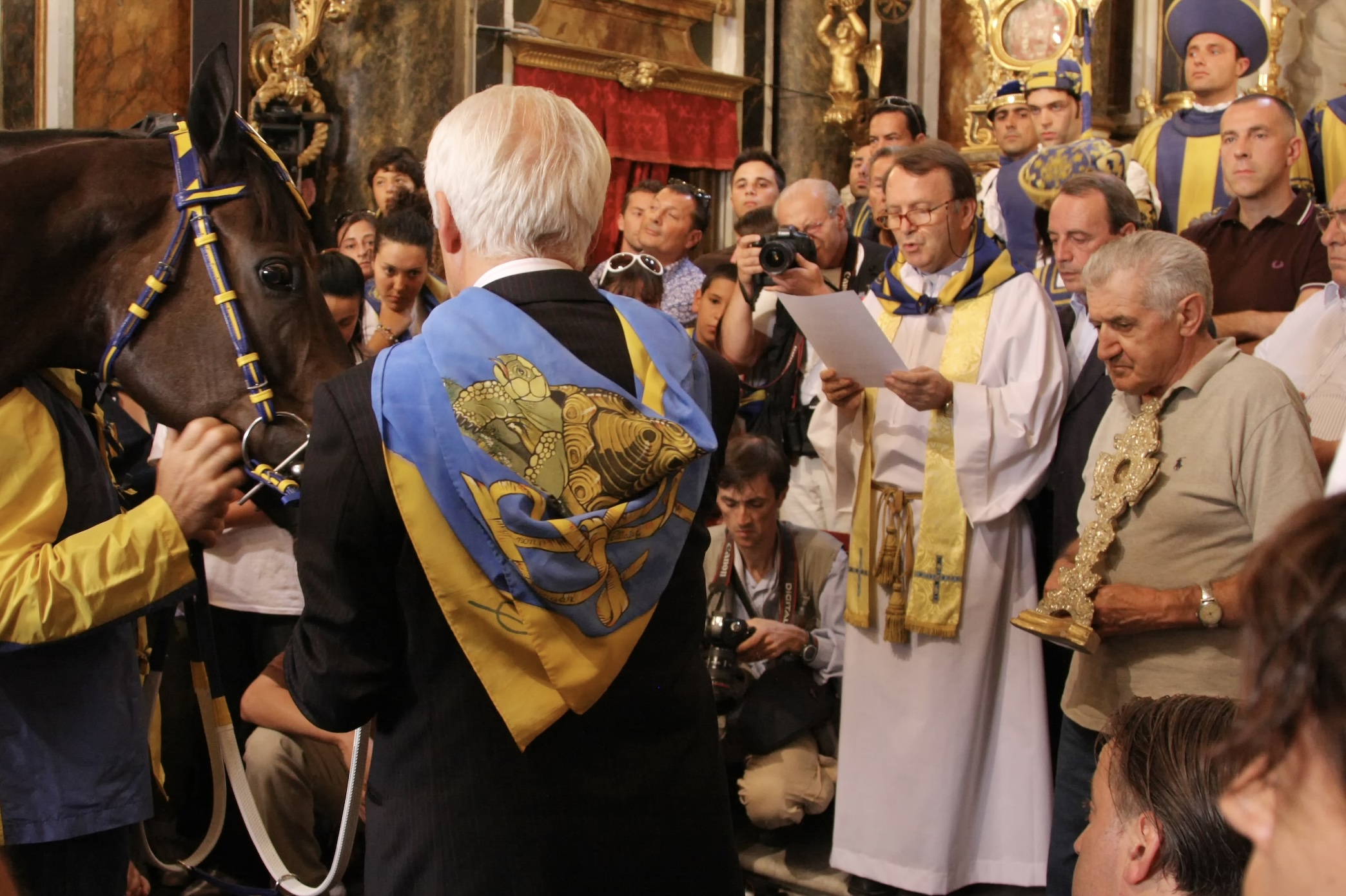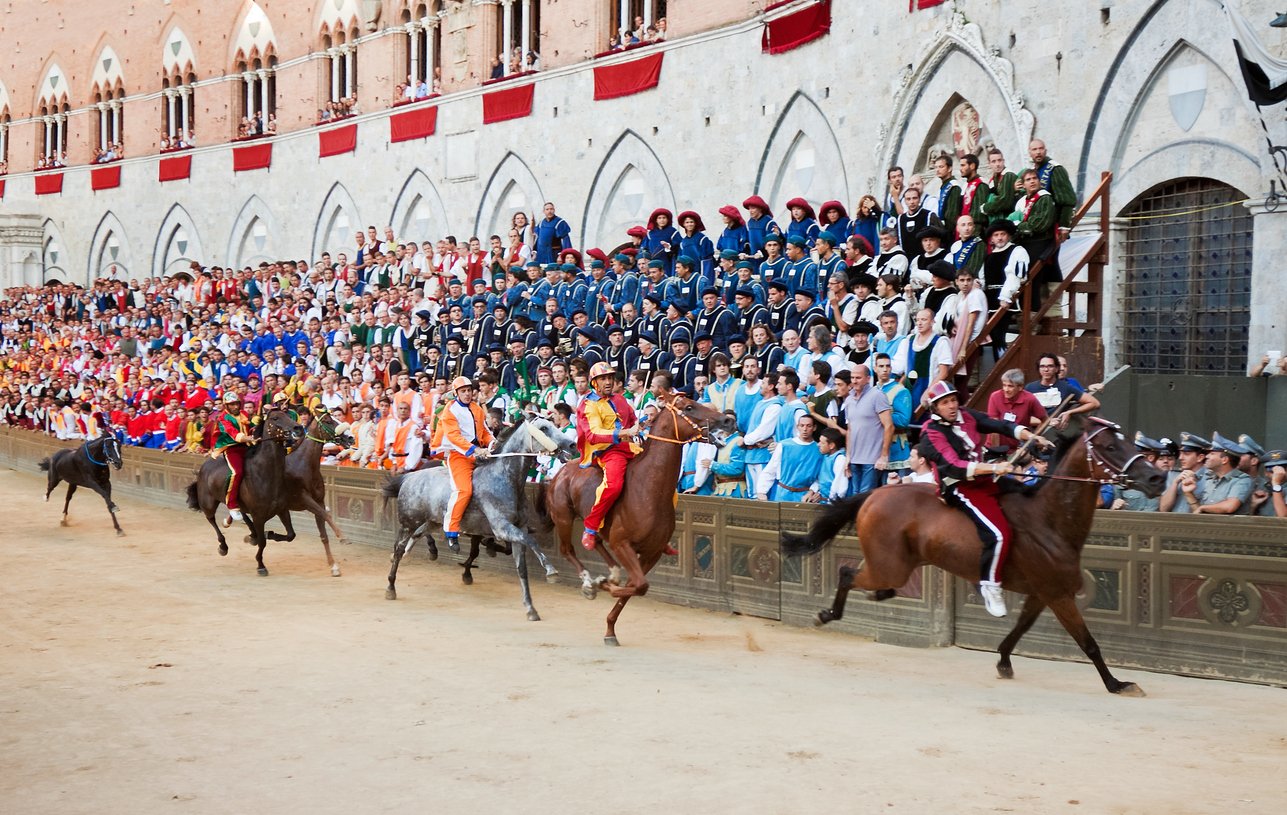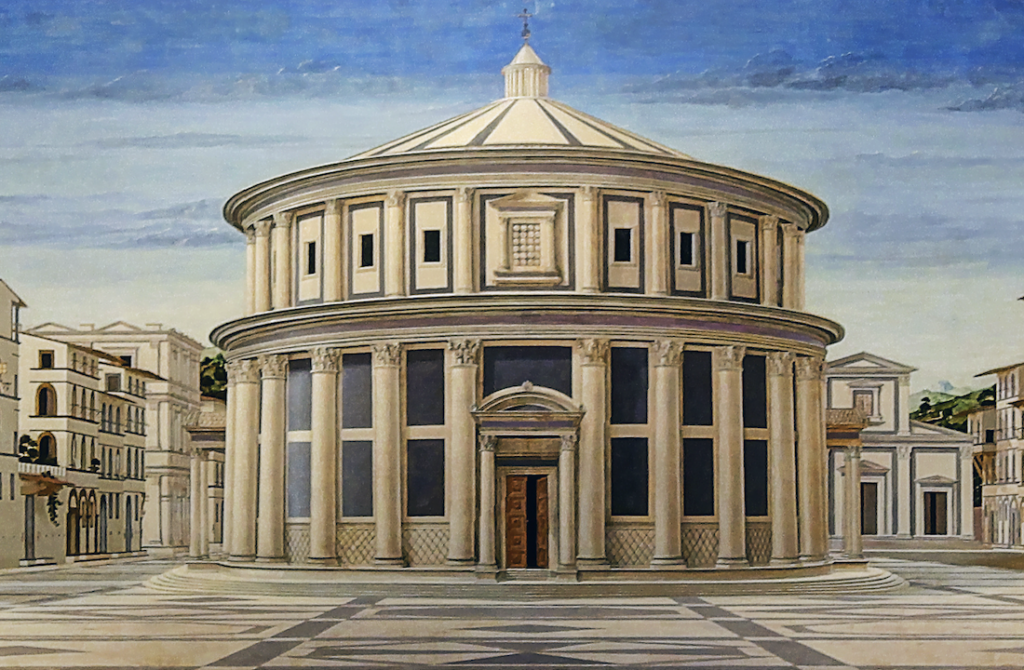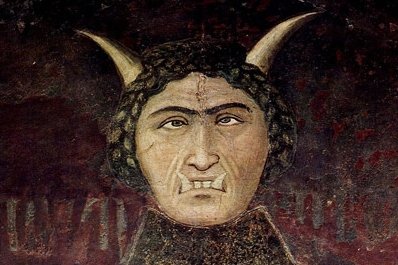“Cheer up, there’s dirt in the piazza!”
Although much of the nuance is lost in translation (“Coraggio, c’è terra in piazza!”), this expression best embodies what the Palio means for the Sienese. That no matter the gravity of one’s predicament, ailment or loss, if there is dirt in the piazza – ie. clay covering the outer perimeter of Siena’s central square, the Piazza del Campo – then it is Palio time. (see below) And if it is Palio time, then the possibility of winning the race, or of watching one’s enemy contrada lose it, dramatically outweighs any mundane personal, familial or professional issues. As I wrote in my last blog winning the Palio is the single most important achievement in the life of every Sienese citizen.

Piazza del Campo in the preparation of the sandy substrate for the place of the Palio horse race, with the Public Palace, Siena, Tuscany, Italy
Approximately one week before each of the two races, which are held on July 2 and August 16 respectively, wooden bleacher seats are erected around nearly the entire circumference of the Piazza del Campo. Tons of clay ground are then transported to cover the grey-flagstone-perimeter of the square. In the blink of an eye, the most beautiful medieval urban space in Italy is transformed into racetrack. As the piazza transforms, so too does its surrounding city, as palpable anticipation and excitement build up to a series of climactic moments.
The first of these moments occurs four days before each race, on June 30 and August 13 respectively, when the Fates play their part in this better-than-Shakespearean drama when the racehorses are assigned by lottery to the competing contrade. The actual process of assigning the horses by sortition involves:
- Two pools of balls – one pool of balls with the numbers of the ten horses and the other with the symbols of the ten contrada running in the palio
- A little boy or girl who actually draws a ball from each pool arbitrarily assigning a horse to a contrada
- The mayor of Siena who serves as the guarantor that it all unfolds fairly

Crowd of people in Piazza del Campo square in Siena, Italy, watching traditional Palio di Siena horse race.
As the sortition unfolds in the jammed-to-beyond-capacity piazza, you can hear the flutter of a hummingbird’s wings from a mile away. Such is the degree of anticipation in the hopes of being assigned a fast horse and the terror of being assigned a slow one. Of course, the perfect scenario is being assigned a good horse and having one’s enemy contrada assigned a bad one. Vice versa, a slow, violent death is preferable to being assigned a bad horse while watching your enemy contrada return home with the favorite to win the race.
One by one all 10 horses are assigned, and to each match, the crowd reacts with cheers, jeers and tears as the quality of an assigned horse either inflates hopes further or simply dashes them to bits. And as the horses are collected by the respective barbaresco, or horse groom, of a contrada and brought back to the five-star stalls of their neighborhoods, the next critical phase begins – hiring a fantino, or jockey.
A majority of the fantini are Sardi (from the Italian island of Sardegna) or Tuscan, and also race for other horseracing circuits in Italy and Europe. The cost of a fantino is based on his reputation and record of success. Those who have won many races are seen as nothing less than demi-gods, and demand Olympian honorariums. The choice of a fantino largely reflects the quality of the horse assigned to a contrada or to its rival. In other words, if a contrada is assigned a fast horse, it will try its utmost and spare no expense in securing a more able jockey. The same holds true if one’s rival contrada is assigned a fast horse so that securing the most able jockey will prevent one’s enemy from doing so – even if one’s own horse is mediocre. If neither a contrada nor its rival is assigned a strong horse, then it is senseless to spend lavishly on a particularly strong jockey. The money is best saved for a future Palio when fate assigns the contrada a better horse. On the very afternoon that the horses are assigned, the contracted jockey arrives to Siena on foot and is greeted by the capitano of the contrada at the nearest city gate. His reception will be enthusiastic if a hopeful contrada was able to assemble that perfect combination of strong horse and fantino; neutral if a contrada does not feel particularly optimistic about winning; or downright hostile if an enemy contrada possess a strong horse/rider combination. In order to familiarize the fantini and the horses, six trial races are run in the following sequence:
- June 29 – evening trial race
- June 30 – morning and evening trial races
- July 1 – morning and evening trial races
* the evening race is known as the Prova Generale is seen as the official trial race - July 2 – morning trial race
* known as the Provaccia – “the bad trial” as horses simply go through the motion without exertion for fear of senseless injury on the day of the race

After all the drama of transforming a medieval piazza into a racetrack, assigning horses, hiring jockeys and running trial races – in addition to eating, drinking and praying oneself into oblivion – the day of the Palio finally arrives. Every July 2 the daily schedule runs as follows:
- 8am – the Messa del Fantino, or “Mass of the Jockey”, which takes place at the Cappella di Piazza, directly in front of Palazzo Pubblico. It is here that the bishop of Siena blesses all the jockeys
- 10am – the capitano of each contrada signs a contract to guarantee the participation of the fantino. Once signed, there can be no substitute for a jockey regardless of the circumstance – even illness or death
- 2-3pm – horse blessing in the contrada chapel. At some point during this hour, the horse is brought into the actual consecrated chapel or church of the contrada and blessed by the contrada priest. His exact words are “Go forth and come back a winner!” *it is worth noting that if a horse urinates or defecates while in said chapel, it is seen as a good omen!!!!
- 3-5pm – the Comparsa, or “group of people in historic dress and flag throwers” that will participate in the parade” of all 17 contrade – 10 with and 7 without horses begins tour of the city. *stop at Monte dei Paschi Bank (the world’s oldest extant bank) *stop at Siena Cathedral where the bishop of Siena salutes the procession
- 4:20pm – Mounted Carabinieri parade and then charge in formation in the Piazza del Campo
- 5pm – the Sfilata, or “ceremonial procession” enters into Piazza del Campo, processes around racetrack and each Comparsa (see above) is judged for the quality of costume and ability in flag throwing as they walk around the entire square
- 6pm – the Carroccio di Montaperti, or “medieval war cart” used at the Battle of Montaperti in 1260 (listen to my podcast) enters race track and transports the sacred Palio – the silk standard which is awarded to the winner of the race – to its place of honor at the mossa, or “starting line” of the race
That is a full ten hours of pageantry, prayer, parading! For a race that lasts approximately 90 seconds!!!!!
The religious invocations, the ubiquitous beating of drums throughout the city, the slow ceremonial pace of the procession, and the constant singing of the contradaiouli are all part of a social phenomenon that is nothing less than a nearly trance-inducing-primordial-tribal ritual. And then suddenly the spell is broken by a deafening mortar explosion and white flags flying on the Palazzo Pubblico to signal the entry of the horses onto the racetrack. The roar of the crowd shakes the walls of the medieval palazzi surrounding the piazza, as the horses approach the mossa (or “starting line”) and wait to discover the order in which they will be aligned at the start. Determined by secret lottery, the order of the horses – numbers 1-9 aligned next to each other within the ropes of the mossa while #10 is assigned the rincorsa or “running start” that ultimately determines when the race begins – is delivered to the mossiere, or “starting line judge”in a sealed envelope. As the horses are called to take their positions, the mossier tries to keep order. Getting ten very excited horses to line up next to each other is no easy task, and often times this process can take hours. While the jockeys are lining up, there is a heated exchange of bribes between them. Each jockey is authorized by his respective contrada employer to offer money to other jockeys for any number of reasons:
- Agree not to try to win
- Agree not to interfere should bribing contrada be winning
- Agree to help in preventing another contrada from winning
- Agree to assist bribing contrada in winning
Jockeys whose sole objective is to prevent a contrada from winning are known as assassini and are usually compensated handsomely. Of course, while a jockey is offering bribes, he is also being offered bribes by other jockeys. In order to ascertain that a jockey is only obeying contrada instructions and not making personal deals, lip readers have become a standard presence by the mossa. And those jockeys who do throw races know to make careful escape preparations in order to avoid lynching after the race (I am not kidding). While all this is happening, very often rival jockeys trying not to give an opponent an edge will begin whipping an adjacent horse and/or jockey with his nerbo or “whip” which is made from a dried bull phallus. These nerbate or “rapid exchange of whipping blows” can get quite violent and often lead to the mossiere expelling all the horses and starting the alignment process from scratch.
Finally, when the horses seem to be maintaining orderly and stable positions, it is up to horse #10 to rush the cord, and if the mossier believes it is a clean start, he will drop the canape, or “starting rope,” … and they’re off!!!!!
To find out what happens next, join me on my Palio Program in July 2021 (2020 Program sold out)!





















